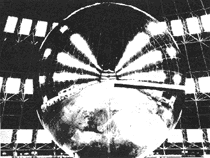Echo 1, 1A, 2
 The Echo satellites were NASA's first experimental communications satellite project. Each spacecraft was a large metallized balloon designed to act as a passive communications reflector to bounce communication signals transmitted from one point on Earth to another. Following the failure of the launch vehicle carrying Echo 1, Echo 1A (commonly referred to as Echo 1) was successfully orbited, and was used to redirect transcontinental and intercontinental telephone, radio, and television signals. The success of Echo 1A proved that microwave transmission to and from satellites in space was understood and demonstrated the promise of communications satellites. The vehicle also provided data for the calculation of atmospheric density and solar pressure due to its large area-to-mass ratio. Echo 1A was visible to the unaided eye over most of the Earth (brighter than most stars) and
was probably seen by more people than any other man-made object in space. Echo 2 continued the passive communications experiments, and also investigated the dynamics of large spacecraft and was used for global geometric geodesy. Although NASA abandonded passive communications systems in favor of active satellites
following Echo 2, the Echo systems demonstrated several ground station and tracking technologies that would be used by active systems. Echo 1A reentered on May 24, 1968 followed by Echo 2 on June 7, 1969.
The Echo satellites were NASA's first experimental communications satellite project. Each spacecraft was a large metallized balloon designed to act as a passive communications reflector to bounce communication signals transmitted from one point on Earth to another. Following the failure of the launch vehicle carrying Echo 1, Echo 1A (commonly referred to as Echo 1) was successfully orbited, and was used to redirect transcontinental and intercontinental telephone, radio, and television signals. The success of Echo 1A proved that microwave transmission to and from satellites in space was understood and demonstrated the promise of communications satellites. The vehicle also provided data for the calculation of atmospheric density and solar pressure due to its large area-to-mass ratio. Echo 1A was visible to the unaided eye over most of the Earth (brighter than most stars) and
was probably seen by more people than any other man-made object in space. Echo 2 continued the passive communications experiments, and also investigated the dynamics of large spacecraft and was used for global geometric geodesy. Although NASA abandonded passive communications systems in favor of active satellites
following Echo 2, the Echo systems demonstrated several ground station and tracking technologies that would be used by active systems. Echo 1A reentered on May 24, 1968 followed by Echo 2 on June 7, 1969.
Spacecraft
1, 1A: each was a 30.5 m diameter balloon made of 0.0127 mm thick mylar polyester film. A set of 107.9-MHz beacon transmitters were carried for telemetry. The transmitters were powered by five nickel-cadmium batteries that were charged by 70 solar cells mounted on the balloon.
2: a 41.1 m diameter mylar balloon that used an improved inflation system to improve the balloon's smoothness and sphericity. Instrumentation included temperature sensors to monitor the balloon's skin temperature and pressure sensors to monitor the balloon's internal pressure. A beacon system, consisting of two transmitter assemblies, provided tracking and telemetry signals. The beacon system used solar cell panels
for power and had a minimum power output of 45 mW at 136.17 MHz and 136.02 MHz.
Payload
No scientific payloads were carried on any of the missions. Echo 1's surface was used to reflect 960 and 2390 Mhz signals. Echo 2 experimenters utilized 162 Mhz signals.
| Country of Origin | United States |
| Customer/User | NASA, GSFC, Langley |
| Manufacturer(s) | Sheldahl, Grumman |
| Size | 1, 1A: 30.5 m dia. sphere / 2: 41.1 m dia. sphere |
| Orbit | 1A: Initial parameters 1519 x 1687 km, incl. = 48.6 deg. / 2: Initial parameters 1032 x 1315 km, incl. = 85.5 deg. Both spacecraft encountered significant orbital changes due to solar pressure. |
Launch Facts
| Name | Int'l Desig. | Date | Site | Vehicle | Orbit | Mass(kg) |
| Notes | ||||||
| Echo 1 | none | 5/13/60 | ESMC | Delta | FTO | 56 |
| 2nd stage attitude control failure | ||||||
| Echo 1A | 1960-[Iota]1 | 8/12/60 | ESMC | Delta | LEO | 76 |
| Balloon; passively relayed TV and voice transmissions | ||||||
| Echo 2 | 1964-004A | 1/25/64 | WSMC | Thor Agena B | LEO | 256 |
| Passive commsat; balloon; 1st joint US/USSR space mission | ||||||
Information in The Mission and Spacecraft Library is provided without warranty or guarantee. USE AT YOUR OWN RISK.